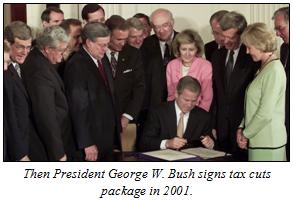Krugman Views Tax Cuts as an “Expensive Proposition” But not “Stimulus” Legislation
By Kevin Mooney
Whatever voters may think of former President George W. Bush these days, they think very highly of their disposable income, cost of living and bank accounts. That’s why it’s smart politically for Republicans to call for an extension of the Bush tax cuts set to expire at the end of this year.
But it’s also makes good public policy, contrary to what New York Times columnist Paul Krugman has argued. With the U.S. still mired in recession, now would be a particularly bad time to further burden Americans with tax rate increases. Here’s what the expiration will mean for working families and average citizens.
• 35 percent bracket which will increase to 39.6 percent
• 33 percent bracket which will increase to 36 percent
• 28 percent bracket which will increase to 31 percent
• 25 percent bracket which will increase to 28 percent
• 10 percent and 15 percent will condense to 15 percent
• The capital gains tax will increase from 15 percent to 20 percent
• The tax on dividends will increase from 15 percent to 39.6 percent
In his latest column, Krugman predictably claims that only the richest Americans will benefit from an extension of the Bush tax cuts. But congressional Democrats and liberal columnists have a very elastic view of the rich in America. Small business owners and two-income families beset with high living costs are considered too rich from the vantage point of Capitol Hill.
“What’s at stake here?” Krugman asks. “According to the nonpartisan Tax Policy Center, making all of the Bush tax cuts permanent, as opposed to following the Obama proposal, would cost the federal government $680 billion in revenue over the next 10 years. For the sake of comparison, it took months of hard negotiations to get Congressional approval for a mere $26 billion in desperately needed aid to state and local governments. And where would this $680 billion go? Nearly all of it would go to the richest 1 percent of Americans, people with incomes of more than $500,000 a year. But that’s the least of it: the policy center’s estimates say that the majority of the tax cuts would go to the richest one-tenth of 1 percent.”
In point of fact, the rich are absorbing more of the tax burden now than ever before. This is a hard fact that Krugman and others repeatedly omit from their analyses. Higher income households saved more in actual dollars from the 2001 and 2003 tax cuts only because the poorer households paid very little taxes in the first place. The Heritage Foundation has just released a study that exposes and debunks ten of the top myths economically illiterate columnists continue to circulate.
“In 2000, the top 60 percent of taxpayers paid 100 percent of all income taxes. The bottom 40 percent collectively paid no income taxes,” the study explains. “Lawmakers writing the 2001 tax cuts faced quite a challenge in giving the bulk of the income tax savings to a population that was already paying no income taxes.”
“Rather than exclude these Americans, lawmakers used the tax code to subsidize them,” the report continues. “(Some economists would say this made that group’s collective tax burden negative.) First, lawmakers lowered the initial tax brackets from 15 percent to 10 percent and then expanded the refundable child tax credit, which, along with the refundable earned income tax credit (EITC), reduced the typical low-income tax burden to well below zero.”
Even when Krugman is forced to concede that certain tax cuts benefit the middle class, he views them as an “expensive proposition.” But why is government spending left out of the equation? President Obama has just called for another $50 billion in “stimulus spending” that will supposedly jumpstart the economy — this added on top of previous spending packages, to say nothing of runaway entitlements. As it turns out, allowing the political class to have a larger slice of taxpayer earnings is also an expensive proposition.
Another missing piece concerns the accelerated economic activity that followed from the Bush program. In retrospect, the tax cuts were just what the doctor ordered after the 9/11 terror attacks. But it’s important to understand why. Here again, the Heritage study is quite helpful and insightful.
“Government spending does not ‘pump new money into the economy’ because government must first tax or borrow that money out of the economy,” the report explains. “Claims that tax cuts benefit the economy by ‘putting money in people’s pockets’ represent the flip side of the pump-priming fallacy. Instead, the right tax cuts help the economy by reducing government’s influence on economic decisions and allowing people to respond more to market mechanisms, thereby encouraging more productive behavior.”
Although Bush left office as an unpopular president, history is beginning to catch up with the wisdom of his tax policies. In fact, it could be argued that they may have been the most well-timed tax cuts in history given the destruction in NYC. A new poll in the critical state of Ohio shows that a majority would prefer him back in office over the incumbent.
Regardless of who is up or down in the current political cycle, there’s no escaping a key lesson evident in recent history: Supply side tax cuts increase revenue and heighten economic activity every time they are tried.
Kevin Mooney is a contributing editor to Americans for Limited Government (ALG) News Bureau and the Executive Editor of TimesCheck.com.



